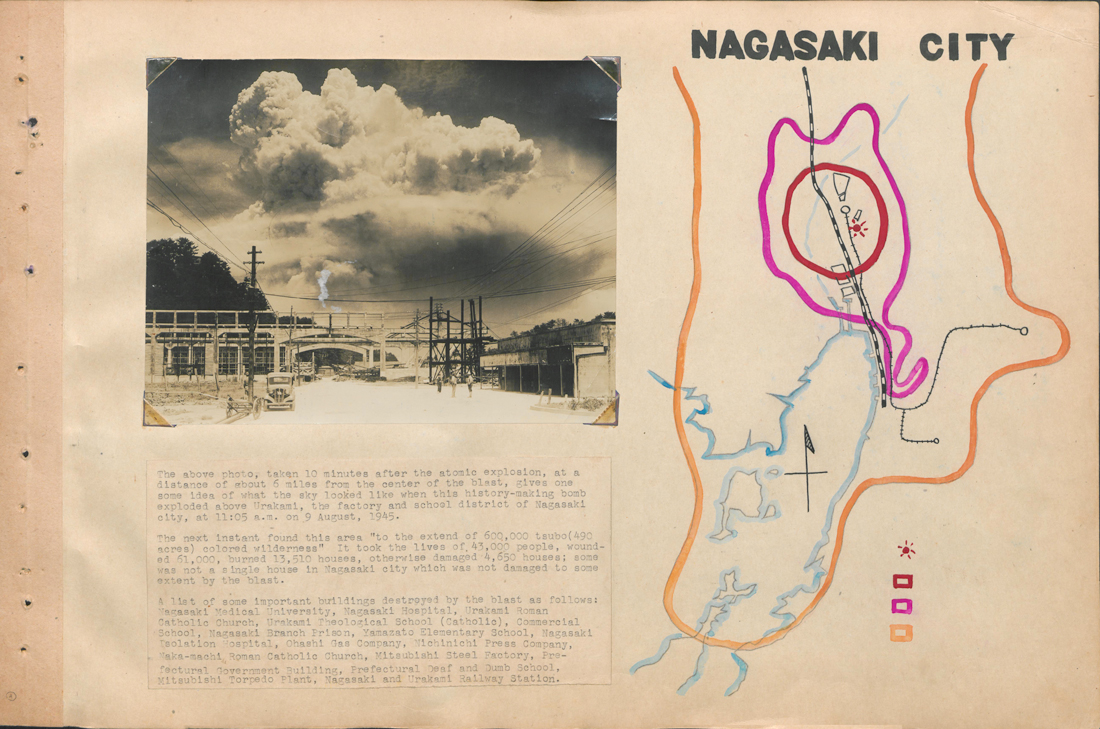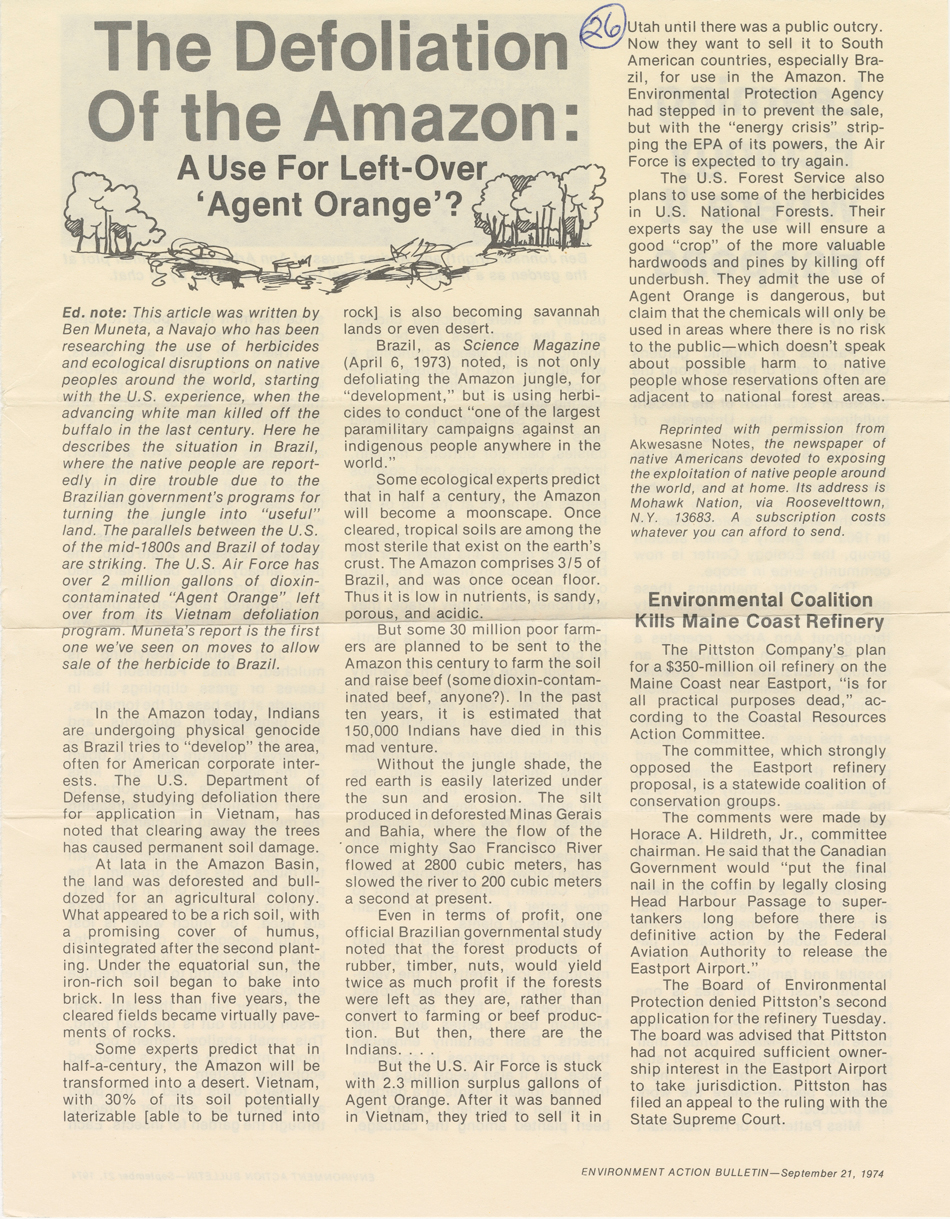Forest for the Trees
The environmental justice movement gained momentum in the United States, but it is certainly not restricted to one country. Environmental injustice and racism are global phenomena. In recent years, the United Nations General Assembly made environmental justice a priority, recognizing that having a healthy, safe environment to live in is a human right.
"the promotion of the human right to a clean, healthy and sustainable environment required the full implementation of the multilateral environmental agreements under the principles of international environmental law"
—U.N. General Assembly, July 26, 2022
Below, we cover the ways in which environmental injustice and racism occur through the creation and use of nuclear and biological weapons, and foreign trade and industrialization. In the United States and abroad, we see the ecological devastation of radioactivity and herbicide, and the impacts of pollution and unsafe working conditions on human health.
Information access and transparency is key in preventing further environmental harm before it happens. Acts of environmental injustice occur all across the globe, but so does environmental justice activism: communities rising up to fight for healthy and safe places to live.
 Crews clean up dead fish that are a result from industrial pollution, 1972. Baltimore News American collection, UMD Special Collections and University Archives.
Crews clean up dead fish that are a result from industrial pollution, 1972. Baltimore News American collection, UMD Special Collections and University Archives.
Global Case Studies
Japan
We discussed national implications for the creation and use of radioactive nuclear weapons and energy with the Navajo Nation, but here we present a prime example of environmental injustice done on a global scale. After the devastating end of World War II in which the United States dropped atomic bombs on Hiroshima and Nagasaki, Japan, censorship efforts were made by the United States to prevent the Japanese public from learning about the long term ecological and genetic impacts of the nuclear bombs.
 Pages from Hiromichi Matsuda's personal album, 1949. Victor E. Delnore Papers, Gordon W. Prange Collection, UMD Special Collections and University Archives. Click to enlarge.
Pages from Hiromichi Matsuda's personal album, 1949. Victor E. Delnore Papers, Gordon W. Prange Collection, UMD Special Collections and University Archives. Click to enlarge.
 Pages from Hiromichi Matsuda's personal album, 1949. Victor E. Delnore Papers, Gordon W. Prange Collection, UMD Special Collections and University Archives.
Pages from Hiromichi Matsuda's personal album, 1949. Victor E. Delnore Papers, Gordon W. Prange Collection, UMD Special Collections and University Archives.
 Dateline newswire distributed by Kyodo-AP, stamped "HOLD" and "SUPPRESS," November 1, 1947. Gordon W. Prange Collection, UMD Special Collections and University Archives. Click to enlarge.
Dateline newswire distributed by Kyodo-AP, stamped "HOLD" and "SUPPRESS," November 1, 1947. Gordon W. Prange Collection, UMD Special Collections and University Archives. Click to enlarge.
Mexico
Implemented in 1965, the Mexican maquiladora program allowed foreign companies to bring materials into Mexico for manufacturing without having to pay a tax. Although the program provided work for those living in the northern border cities of Mexico, this work came with low wages, unsafe working conditions, and exposure to toxic chemicals emitted by the factories and manufacturing plants. Throughout the second half of the twentieth-century, border town communities were not protected from toxins emitted by the maquiladoras by environmental laws and policy, nor proper waste storage and treatment facilities. Not only did workers face risk working in the maquiladoras, but whole communities were impacted by the maquiladoras-caused air pollution. Bodies of water were also impacted by the maquiladoras, pollution entering the Rio Grande, impacting the wildlife there and a source of food and income.
 “The Maquiladoras and Toxics: The hidden costs of production South of the border.” AFL-CIO Publications, UMD Special Collections and University Archives.
“The Maquiladoras and Toxics: The hidden costs of production South of the border.” AFL-CIO Publications, UMD Special Collections and University Archives.
Brazil
The 1974 article, “The Defoliation of the Amazon: A Use For Left-Over ‘Agent Orange’?” describes the long term environmental impact of Brazilian and United States industry on the Amazon Rainforest. Typically when we think about the Amazon Rainforest and the environmental hazards it faces, the image of thousands and thousands of trees being cut down comes to mind. Ben Muneta’s article describes how what was once rich soil in the Amazon was now more like rock due to the lack of tree coverage. What does this have to do with Agent Orange? Agent Orange is an herbicide mixture used by the United States during the Vietnam War to defoliate Vietnamese land. The herbicide does not only impact the land, but the people living on it. It can lead to various kinds of cancer, skin disease, and eventual birth defects. When United States troops left Vietnam during the 1970s, the U.S. Air Force still retained 2.3 million surplus gallons of Agent Orange. One proposal was to sell the remaining Agent Orange to South American countries, specifically, Brazil, for use in the Amazon. Muneta points out how, when it comes to acts of defoliation and the spraying of toxic chemicals, Indigenous populations are not taken into account. At the same time that the United States was trying to sell Agent Orange to those who would clear our rainforest land, the U.S. Forest Service was making plans to use some of these herbicides in the U.S. National Forests, claiming that there was no public risk in their plan. Muneta disagrees, however, pointing out the “possible harm to native people whose reservations often are adjacent to national forest areas.”
 Environmental Action Bulletin article: "The Defoliation of the Amazon," by Ben Muneta, 1974.Baltimore Environmental Center Records, UMD Special Collections and University Archives. Click to enlarge.
Environmental Action Bulletin article: "The Defoliation of the Amazon," by Ben Muneta, 1974.Baltimore Environmental Center Records, UMD Special Collections and University Archives. Click to enlarge.
